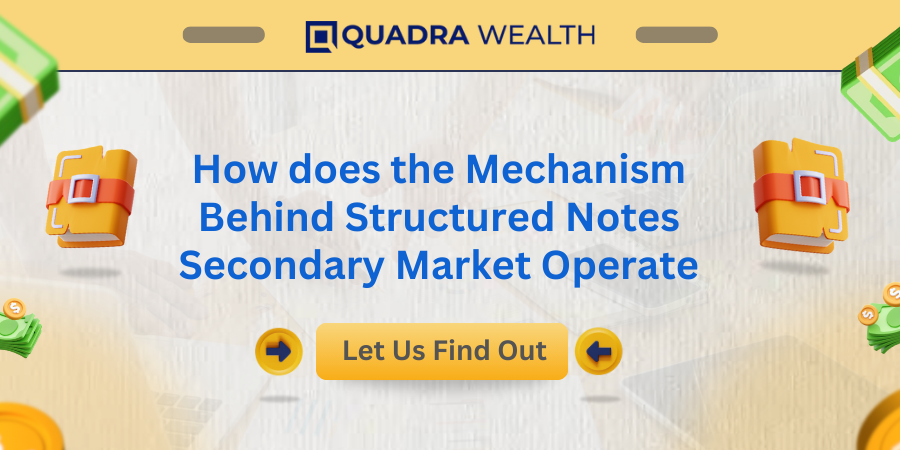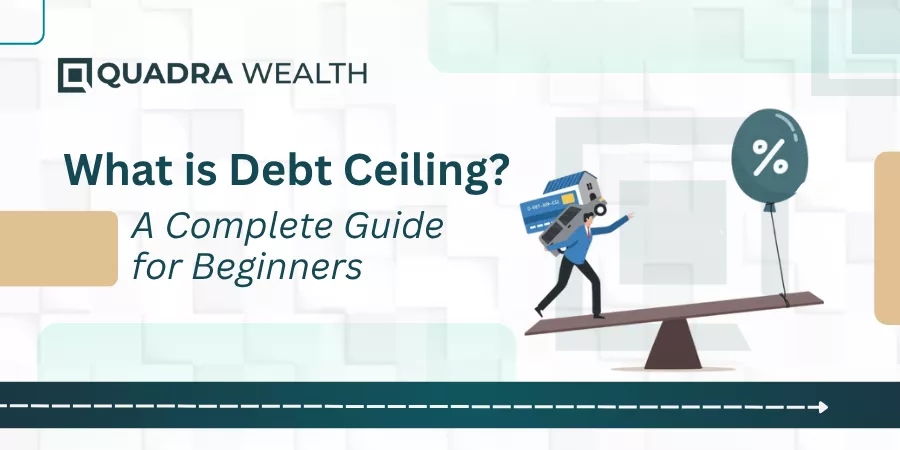In this blog, we will understand the underlying mechanism behind structured notes secondary market. Let us understand why investors might be interested in buying structured notes in a secondary market, the benefits of procuring the same, and a lot more. Stay tuned to reading the blog until its end.
Introduction
In a secondary market, you find that the marketplace is for intermediaries and retailers that buy and sell equity shares, mutual funds, or even exchange-traded funds or etfs.
Brokers and dealers buy equity or derivative products from investment bankers, sellers, and stock-holding corporations. The investment products are calibrated in the form of equity bundles like stocks, shares, real estate bonds, and other tradable products that can easily be bought and sold by merchants, dealers, and retail segment investors on the whole.
In this parlance, let us further deep dive into the underlying mechanism behind structured notes secondary market on a detailed and comprehensive note.

What are structured notes- Meaning and conceptualization explained
Structured notes are hybrid investment products that combine debt and equity. The debt component is a fixed element comprising a promissory bond that is issued in the name of the investor. It is the debt component that provides contingent protection to investor’s capital by at least by considerable extent indeed.
The other part of the note comprises a variable component comprising of derivative or equity-related assets. These are also known as underlying assets comprising shares, independent stocks, a basket of securities, and currencies, to name a few.
While the bond or the debt element mitigates losses for the investor, the upside gains or returns of the investment are based on the performance of the underlying assets the notes are linked with.
With the inclusion of buffers, spreads, or capped barriers, the notes protect investors against unforeseen losses or capital erosion allowing the portfolio to grow at a steady pace indeed.
Structured notes in a primary market
Structured notes are usually issued by investment bankers, capital-intensive financial institutions, and investment biggies to high-net-worth retail as well as institutional investors.
These notes were issued in the primary marketplace as this was a first-hand sale of the agreement between the issuer and the investor.
However, with growing interest amongst Gen Z millennials in wanting to invest in these novel notes, this dynamics has changed drastically. The technological advent also paved the way for the changing landscape with respect to how finances or investments worked.
Emergence of structured notes in a secondary market
With the excitement and the ushering desire for more retail segments to buy structured notes, the financial system has now allowed more and more retail investors to purchase the notes at affordable price ranges.
Investors can buy these notes across secondary marketplaces like banks, financial corporations, and stock exchange firms.
For instance, autocallable notes are available in denominations of $1000 each and investors can keep adding products into their investment portfolios using multiples of 1000.
This way, you get lucrative benefits that the notes can offer you on a budget that can be afforded by you.
Therefore, the emergence of structured notes or products via secondary marketplaces has turned into a boon for middle-class retail investors that were once available only to the posh and sophisticated high-net-worth retail and institutional investors.
Benefits of availing structured products in secondary marketplaces
You have numerous benefits of availing the notes via secondary marketplaces. Helping you through with a run-down into the same:
- Lower price-range
You can avail the notes with a compilation of the bond component and the investment-related portfolio covering the derivative component of the structured product you have in mind.
The notes are determined based on their Net Asset Values i.e. NAVs of independent underliers the notes are linked to. And then, the prices are curated for the overall product.
Therefore, structured notes in a secondary market are way less than what you avail in a high-end primary marketplace.
In a nutshell, as notes are hybrid types of investments offering better yields over traditional bonds, etf, or even mutual funds, getting them at lower prices add to brownie points for the investor.
- Improved liquidity
Independent owners of structured notes give away their notes to banks or product-issuing firms at second-hand prices. This is because they have dire requirements for cash holdings or money to take care of their immediate financial needs.
The owners sell their notes to contemplate a medical emergency or towards an immediate payment of a rental deposit to the owner or to pay the school tuition fees of their children before their due dates.
Therefore, the noteholders are forced to withdraw their portfolios and sell them back to product issuers or via secondary marketplaces.
Therefore, the pricing here might not be as expensive as the prices at which the sellers bought them.
Independent sellers try disposing of their structured notes amongst secondary marketplaces at their current market prices. Therefore, there is a circulation of notes at secondary marketplaces with an improved degree of liquidity as compared to lack of liquidity at the primary marketplace.
- Better options for investments
When owners of structured notes sell them at secondary marketplaces, they can refurbish their capital investments towards more profitable sources of investments.
Say, for instance, an investor may sell his 4-year autocallable notes to re-invest in 2-year- auto-callable notes as the interest rates are better in the latter as compared to the former.
Or, the investor may find that etfs or exchange-traded funds have better terms of investment over his existing type of structured portfolio.
Therefore, when investors sell their notes in secondary markets, they can divert the same level of investment towards more profitable avenues of investment options.
- Flexibility to buy or sell notes at stock exchange firms
Just as shares or securities that are regularly traded at stock exchanges, the investors of notes also can sell their notes or allow independent buyers to buy from secondary marketplaces comprising stock market firms or stock-holding corporations at compatible price ranges.
This way, secondary note holders get better exposure over their pricing and payoff schemes, giving them added flexibility to buy or sell notes whenever they feel like it.
By allowing these notes to circulate amongst secondary marketplaces, you allow for more transparent methods of buying and selling notes amongst independent buyers or sellers as against expecting a product issuing firm alone to take control over your investment portfolios.
Therefore, when investors circulate the notes within secondary marketplaces, they have a better degree of flexibility and control over pricing dynamics which is an important consideration or benefit the investors have over their notes.
- Reduced tax implications
In a primary marketplace, the value of one structured note starts at a premium price range of 1 million US dollars and above. Therefore, the notes may garner heavier tax implications on the returns the note gathers from the perspective of investing.
On the other hand, when buyers opt for notes that are sold at secondary marketplaces, they get well-defined and reduced tax implications over their primary counterparts.
However, getting tax guidance from a tax consultant gives you well-informed cues on how tax implications occur on structured notes bought from a primary market and those notes that are procured from a secondary marketplace.
What are the challenges for notes that are sold in secondary market places- Detailed insights explained
These are the following challenges with respect to notes that are sold across secondary marketplaces. Helping you through a run-down into the same:
- Scouting suitable buyers may be difficult
Finding suitable buyers for structured notes might be difficult as these notes have a higher degree of customization that suits independent buyers. The terms of the notes are customized keeping independent investor’s preferences in mind.
Therefore, finding suitable buyers who find the notes enticing or lucrative might not be that easy. Here, the buyer must also find value in the investments for them to zero the deals on notes that are to be sold by independent sellers.
- Might not close profitable deals for sellers
When independent sellers try to dispose of their notes via secondary outlets, they may not be able to demand the similar prices at which they had bought these notes.
Therefore, the sellers may have to shell out these notes at prevailing market prices that may not be profitable closure deals for the sellers.
As an investor who wishes to sell his notes in the secondary marketplace, the guarantee of getting a complete value of the primary or principal investment on the notes is not higher on the cards.
- Bifurcation of asset values as contained on the original note may vary
You may have certain underlying assets that the notes are linked to. These are underliers with shares, independent stocks, and a basket of mixed securities, or currencies to name a few.
The underliers provide certain rates of returns as specified on the initial terms and conditions of structured products.
However, if these notes are sold via secondary marketplaces, there might be altercations with respect to the way the asset values are bifurcated.
The notes re-sold to buyers may or may not have the same bifurcation of underliers as how the asset allocation was made on the notes at the time they were designed.
In a nutshell, the notes have alterations with respect to how the portfolios were built initially for independent buyers vis-a-vis their product issuers.
Factors affecting the prices of structured notes in the secondary market
These are the factors affecting the prices of structured notes in the secondary market. Let us have a run-down into the same:
- Changing interest rates
Owing to market volatility, interest rates keep fluctuating all the time. The products that give better interest rates would be favored in lieu of products that offer lower interest rates.
As interest rates directly impact the returns on investment with regard to structured notes, changes in the interest-return ratios significantly impact the prices at which structured notes are sold in the secondary markets.
- Market risks
You may have a sudden outbreak of a global recession or an economic downturn that may cause equity-based assets to rise exponentially or face severe slump downs.
As structured notes are linked to equity assets like derivatives, shares, stocks, futures, commodities, or currencies, the value of the investment depends on how favorable the market conditions are.
As the returns on investment for notes are primarily based on the performance of linked-in assets, any kind of economic downturn or other political scenarios that emerge abruptly have a considerable impact on the way the structured notes are priced in the secondary market.
What are the legal implications investors must have while dealing with structured products in the secondary markets?
The US Securities and Exchange Commission is the authority that determines legal implications with respect to the way structured notes are dealt with in the secondary market.
Typical to equities, the legal norms or guidelines with respect to deciding the purchase values and sale prices are determined by the US Securities and Exchange Commission for the US and other global markets on the whole.
The European Federal Agency determines stock values and structured notes that are dealt with in the European markets.
As investors, you can also tune in to the updates as furnished by world-famous stock exchanges like NASDAQ or Wall Street to monitor movements in the buying and selling prices of underlying equities the structured notes are linked with.
Do you engage with the sale of structured notes until they mature or deal with secondary market trading?
Between deciding whether to wait for structured notes to mature or deal with secondary market trading, here are pointers that help you take well-informed moves as to choosing the better option:
- Favorable interest rates
Check whether the interest rates of underlying assets or linked-in assets concerning structured notes show an increasing trend or are embedded with future call options.
This is because favorable interest rates and greener trends of investment options are directly proportional to one another.
In this case, you should choose to retain the notes until their maturity date so that you can avail maximized returns on your investment portfolio as your assets are doing well and you want to capitalize on increased returns your portfolio is gathering.
In the case of Structured notes with principal protection, it is better you maintain them until maturity so that you get complete redemption of your capital investment.
- Dropping interest rates or falling asset values
When interest rates of your underliers keep dropping, then the values of underlying assets also come down. This means the markets are not doing great.
In this case, it is better to opt for secondary trading of notes as you can avail the best market prices instead of your capital investment as against losing it all.
In a nutshell, the performance of one of the underliers dropping or plummeting can also have an impact on the potential value of an investment with respect to structured notes.
- Hybrid market conditions
When the market prices are neither increasing nor decreasing, this becomes more like the yellow signal at the crossroads. You may have to wait before you leap forward.
This is because you do not know what is there on the cards. Therefore, it is an ideal option to wait until you see indicative trends of a greener market with investments.

The Bottom Line
Structured notes in the secondary market also come to you with their own set of benefits or challenges.
Therefore, you must consult a financial advisor before you take a move as to whether you want to sell the notes in a secondary trading place or not.
You must also read through market documents carefully before buying or selling structured products.
What are your thoughts on this? Do let us know in the comments below!






